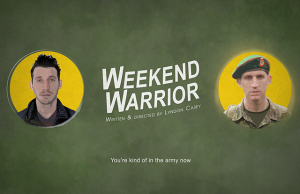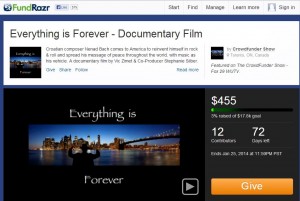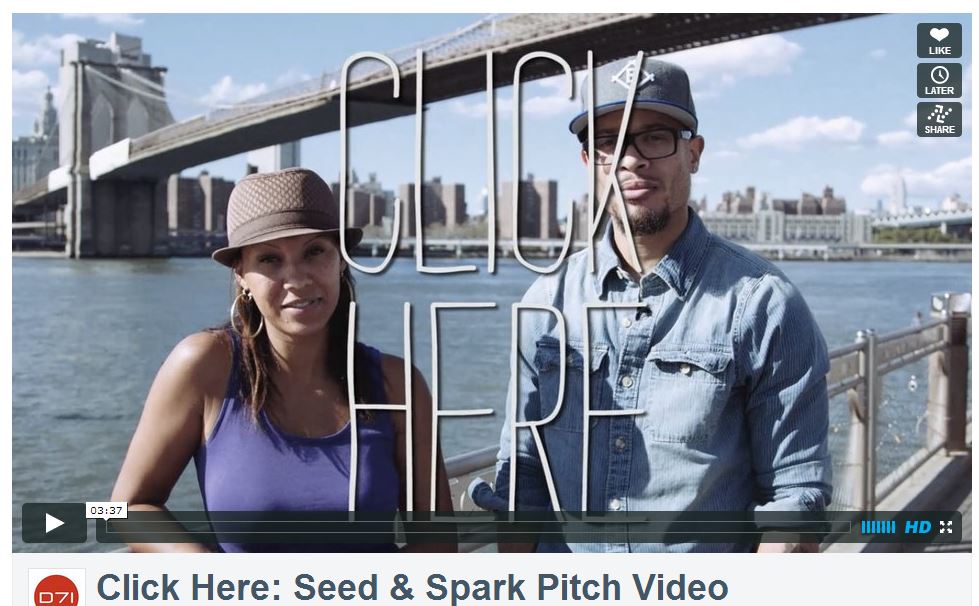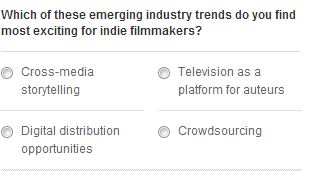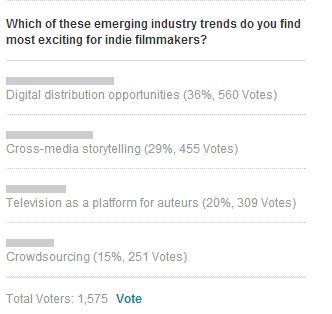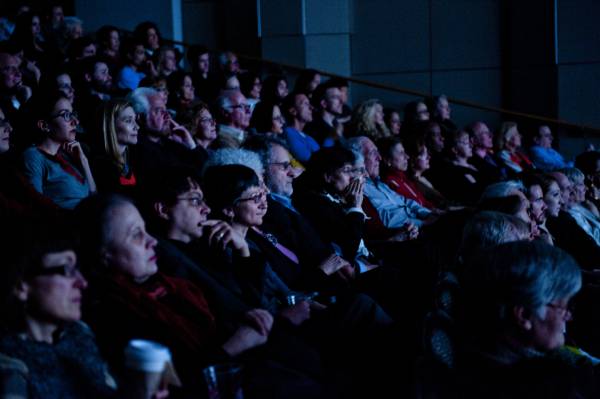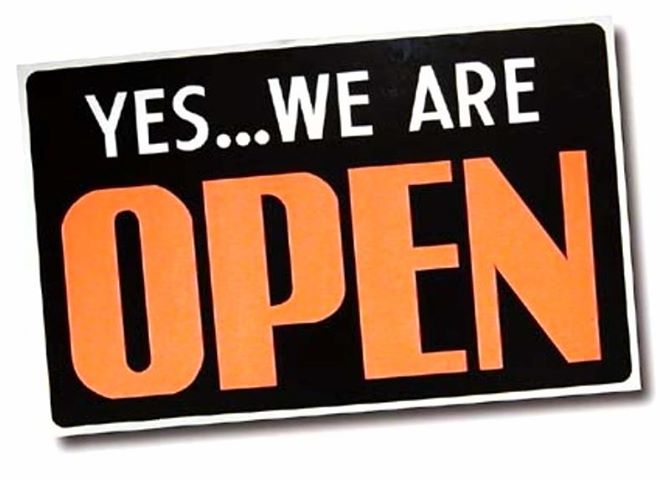
Running more than one crowdfunding campaign
This week, our crowdfunding series will focus on filmmakers who found success on their first campaign and have decided to run a second. Today’s guest post is from Toronto-based filmmaker Shasha Nakhai of Compy Films.
My experience with crowd-funding began with the first film I directed, a 20 minute documentary called THE SUGAR BOWL. The film’s bare bones budget was about $10,000, but I only had about $6,000 raised at the time. In order to make the film happen, I knew I had to raise more money. Being a first-time filmmaker, my options were very limited. I heard about IndieGoGo when I came across another film’s campaign and decided to try it out myself. I set a low goal of $3,000 and ran the campaign on my own. I not only met the goal, but exceeded it raising $3,265 and an additional $1,000 outside of the campaign.
This initial campaign was run during a time when there wasn’t yet a wealth of information available on how to run a successful campaign and I found it very challenging and more of an experiment just to see what would happne. I chose IndieGoGo simply because I live in Canada, and at that time Kickstarter required a US bank account.
I think the main reason behind my project’s success was the subject matter, the personal connection I had to the story and the fact that there was a real lack of films coming from the Philippines. I also had a strong pitch video, even though it was very simple. It was a video of me pitching the film at the Pitch Competition, but my passion for the project really shone through.
The Sugar Bowl – Teaser Trailer from Rich Williamson on Vimeo.
The #1 thing I learned from running a crowd-funding campaign was that I had to leave my pride at the door. You can’t be afraid to ask for things, otherwise you won’t get them! Also, framing what you are asking for is so important. The way you talk about your campaign to others makes a huge difference. For instance, using words like “join us,” “support,” “back,” and “pre-buy” instead of “donate” actually makes a psychological difference. It becomes more about an exchange rather than simply begging for money.
It is also important to have a team to work together on a campaign. It is mentally exhausting to take on a campaign by yourself and I was running myself into the ground trying to plan the trip to the Philippines while at the same time running a 24/7 crowd-funding campaign.
I would say the biggest mistake I made during my campaign was not accounting for the fact that the funds being raised were in USD, not CAD, and that there would be additional wire transfer and conversion costs on top of IndieGoGo’s interest. Another flaw was my lack of updates. If I were to run this campaign today, I would set a higher goal, bring on board a team and be more consistent with social media and updates.
Which brings me now to the campaign I am running today.
Right now I’m producing a short comedy called WEEKEND WARRIOR, directed by Lyndon Casey. Before we started the campaign, I identified my biggest assets. We have assembled an experienced team with strong resumes; the director’s last short film [Captain Coulier (space explorer)] premiered at Sundance 2009; and one of our actors, Dillon Casey, has 20,000 followers on Twitter. Taking all of these into consideration, we decided to set a goal of $15,000, which we are still actively fundraising.
One major advantage we have is being able to tap into already existing mailing lists and social media followers from all of our previous films. Each member of the team is building on their already-existing networks as we move along and we will continue to build on and engage our audiences all the way into production, through to distribution. We’re now creating weekly skits or update videos and actively seeking out media coverage and guest blog opportunities such as this one to keep up momentum.
One important thing we were really missing was a graphic designer on the team. Our most popular perk to date is the only one that has a picture. I realized people are probably not going to be interested in purchasing a tote if they have no idea what it looks like. So to remedy this mid-campaign, we paid a graphic designer to create a tote that people would want regardless of whether it was supporting our film or not. That’s one very important thing remember –assess your campaign along the way to evaluate what is and is not working. Change what you can.
Regardless of the fact that I’ve already run one successful crowd-funding campaign, we’re still finding this one challenging. Perhaps it’s timing – it’s Movember, a typhoon just hit the Philippines, and people are saving for Christmas. Or maybe this kind of film just isn’t for everyone. Whatever it is, we’re confident we’ll be able to overcome it if we continue pushing the project out to wider networks. We’ve got an audience out there and we’re going to find them!
Shasha Nakhai is a filmmaker based in Toronto, Canada with Compy Films. Her award-winning short films have screened at festivals worldwide including the Hot Docs, DC Shorts, LA Shorts, Atlanta, and Aljazeera Film Festivals. Most notably, The Sugar Bowl won Best Film and Best Documentary at the Aesthetica Film Festival, the WIFT-T Award at the Toronto Reel Asian International Film Festival, and was nominated for the Aljazeera Film Festival’s Gold Award. The Sugar Bowl and Joe recently aired in the United States and Europe on ShortsTV and will be released on iTunes later this year.
Sheri Candler November 18th, 2013
Posted In: crowdfunding
Tags: Canada, Captain Coulier, Compy Films, crowdfunding, Dillon Casey, funding goal, indiegogo, Lyndon Casey, Shasha Nakhai, The Sugar Bowl, Toronto, Weekend Warrior
Crowdfunding via TV? Yes, and it won’t cost a dime
Today’s guest post is from Emmy winning producer/director Victor Zimet of Home Team Productions who is actively campaigning for finishing funds to complete a new documentary about Croatian/American composer Nenad Bach called Everything is Forever. But did you know campaigns now have a new promotion outlet on a TV show in Buffalo, NY?
It’s taken fifteen years to make our film, EVERYTHING IS FOREVER. But I never expected the crowdfunding process to consume half a year.
For two months, we wrote and re-wrote copy explaining who we were and what the project is about, cutting trailers for the film and a sizzle reel for our company, HOME TEAM PRODUCTIONS, and shooting on camera wrap-arounds for the campaign pitch video.
It’s been an enormous amount of effort, and it was important for us to emerge from the campaign with adequate funds to finish the film. We chose the flex plan of Indiegogo, in which we could keep what we raised even if we didn’t meet our goal.
Two tips from veteran crowdfunders I found useful were put the F-word back in fundraising, that word being fun. This loosened me up enough to stop taking everything so seriously, and sparked a wave of creativity. One example involved shooting a video replete with music, dancing, and a silly party hat, which became the centerpiece of a virtual birthday party and fundraising event posted on Facebook. That stimulated some donations.
The other piece of advice also involved Facebook; the user creates a Facebook Event announcing the campaign on the first day it is launched. Invite all of your friends and ask them to share which we found to be far more effective than just posting an announcement on a timeline.
After thirty hard-fought days of fun (and anxiety, we’re only human!), we raised two thirds of our goal and were at peace with our efforts.
But it wasn’t over yet.
On the eve of the campaign’s conclusion, we were approached by a producer for THE CROWDFUNDER SHOW, which airs on Fox 29 WUTV in Buffalo, NY, inviting us to be a featured segment on the program. Delighted that our ingenuity made an impression, we accepted. THE CROWDFUNDER SHOW is a half hour weekly show that profiles the best, brightest, and most interesting crowdfunding projects looking to make a mark, follow a dream or improve a community.
On December 29th, our campaign will be featured in a four-minute segment packaged in the half-hour show.[ed. To apply for consideration on the show for your project, go HERE].
Having gone through the rigors of a previous campaign, we were able to supply the necessary material to the show quickly and they had our campaign up on the crowdfunding site FundRazr, where they sponsor projects, within 24 hours.
Now, here’s where it gets really interesting. In our original campaign, we offered perks such as downloads of some of our earlier films, including festival favorite RANDOM LUNACY. We also offered exclusive bonus interviews featuring pivotal figures from the films. Another perk provided an opportunity to do a commentary track on the EVERYTHING IS FOREVER DVD.
THE CROWDFUNDER SHOW sponsors projects on the Fundrazr site and they are providing an extra incentive to donors. They reward contributors with sponsored gift cards for the same amount of money they contribute, up to $100. With this crowdfunding model, what you give – you get! Donors receive a gift card that matches their donation, compliments of retailing giants such as Best Buy, Home Depot, Starbucks, The Gap, and more. The result? People can support our campaign and it will not cost them a dime. This model is a win-win. With the holidays coming up, you bet that I myself will be purchasing some gift cards!
It’s a brave new world in fundraising, and if this is the first wave, we’re excited to be part of it. It will be fascinating to see what donations may result from four minutes of TV time.
Victor Zimet is a veteran of the film and television business with over thirty years experience to his credit. Together with partner Stephanie Silber, he founded HOME TEAM PRODUCTIONS, producing and directing award-winning documentary films, television, and not-for-broadcast projects since 1999. For more information or to donate finishing funds for EVERYTHING IS FOREVER, visit their website.
Sheri Candler November 14th, 2013
Posted In: crowdfunding
Tags: Buffalo, crowdfunding, documentary, Everything is Forever, Facebook, Fundrazr, Home Team Productions, independent film, indiegogo, Nenad Bach, Random Lunacy, The Crowd Funder Show, The Film Collaborative, Victor Zimet
Kickstarting the Apocalypse
Today’s guest post is from Gabriel Diani & Etta Devine who are actively campaigning on Kickstarter for their film Diani & Devine Meet The Apocalypse. They have some sobering news for those looking to wade into crowdfunding.
We knew it would be tough. We’re not famous, our project wasn’t based on an existing brand, and only seven percent of Kickstarter campaigns over $100,000 make their goal. Seven percent.
We’ve run two successful campaigns in the past. One publishing campaign for $30k and a film campaign for for $27k . Because of that experience, we knew we couldn’t hit $100k with our current social media/audience reach, perhaps $60k or $70k…but $100k might as well be $1m.
We decided to do something big and bold for our latest Kickstarter to fund our movie Diani & Devine Meet The Apocalypse. Something to expand our audience and get the attention of press outlets who are becoming weary of crowdfunding stories. With that in mind, we planned a massive 30 plus video Kickstarter campaign featuring our friends and fellow cast members.
We’d start with our main campaign video to introduce ourselves, lay out what the project was about, and give people a hint of what we had in store for the rest of the campaign. We’re not fans of the filmmaker-sitting-in-front-of-the-webcam-crying videos because we believe that if you’re asking people for money to make a movie, you need to show you know how to make a movie.
We stopped cutting our hair or shaving and over the course of four months we went to seven different apocalyptic locations (some up to 3 hours drive away) to shoot the different segments of the video, slowly distressing our costumes until they were dirty rags by the end.
While we were doing that, we also shot thirty mini-shorts called “Apocatips” with the intention of releasing one for every day of the campaign. This would give us new content to post to keep backers engaged and give us new things to talk about. We also put a bunch of our talented friends in them so they would be more enthusiastic about sharing them with their circles when they came out…because we’re sneaky like that.
We also have several famous genre actors with active fan communities and we wanted to target those audiences to pull them into our campaign. We made a video with Armin Shimerman and Harry Groener who are both very well known and respected for their work in “Star Trek” and “Buffy the Vampire Slayer” and targeted the video to those audiences.
Barry Bostwick was going to be in Romania while we were prepping the Kickstarter so we gave him a script outline and he shot a bunch of crazy footage while on set for “Scorpion King 4.” We sifted through all that footage and put this together with our editor Chad Meserve.
But our biggest gun was Janet Varney, the voice of the main character in a popular anime show called “The Legend of Korra.” The audience is rabid, active (because the show is on right now), and a younger demographic that is perfect for understanding what crowdfunding is. We shot a funny video with Janet dressed as her character and knew that it had the potential to go viral.
Has it worked?
We know a lot of people in the crowdfunding world and they have all been very complimentary about not only the quality of the videos, but the quality of our rewards (we believe in giving early adopters to our cause more bang for their buck) and the beauty and clarity of our Kickstarter page (thanks to our designer Lee Thompson).
The Apocatips have done the job of keeping our backers engaged and giving them new things to share and talk about each day, as have the supplementary videos. We’ve gotten some great press, but the pledging through those outlets is way down from when we did our previous campaigns and most outlets seem unimpressed by the quality and quantity of the videos and usually only mention it as an aside.
The biggest surprise was the Janet Varney/Korra video, which exceeded our wildest expectations in terms of fan response. As of this writing, it is over 42,000 views on Youtube, gifs people made from it have been reblogged multiple thousands of times on Tumblr, and all of the comments on the Youtube page have been overwhelmingly positive. It’s difficult to tell because the Kickstarter backend tells you the total pledges that came through Youtube or Tumblr, but not which specific video or post. All of those eyes on the video brought us around 13 pledges…maybe 20 if we’re generous…out of over 42,000 people watching. We had planned on a 0.01% conversion rate. We got about 0.0005%. That miscalculation has certainly made things more challenging, but there’s still hope. As of this writing, we’re at 42% with 10 days to go. It’s not where we’d like to be, but we’ve jumped about $15,000 in the past three days so it’s not impossible.
We’re not sure what all of this means for the crowdfunding ecosystem. There’s lots to dissect and many factors at play including diminishing Twitter influence and how the Facebook algorithm for sharing posts has changed drastically to limit the number of friends/followers our posts are shared with since our last campaign. Our first movie has almost 1,000 “Likes” on its fan page. We shared one of our videos on it and Facebook showed it to 38 of those 1,000. This is (of course) to encourage people to pay money to “boost” or “promote” their posts. We’ve been doing this, but our friends and audience who have been sharing aren’t paying to boost their posts so our message isn’t spreading as far or as fast as it could despite the fact that this campaign has been shared more times on Facebook than the last one (136 vs. over 2,000 at the time of this writing).
Our email list is around 2,000 subscribers and we’ve been emailing our backers once or twice a week. All of our previous backers are on that list, but we also sent project updates from those campaigns within Kickstarter in case our email was going to spam. Our number one referrer to our campaign this time is Direct Traffic, which means clickthroughs are coming mostly from this email list. It’s almost twice the traffic from Facebook which is the complete opposite from our last two campaigns.
If you’re thinking of jumping into your first (or next) crowd funding campaign, be more cautious than usual. Ours is an ambitious project to be sure, but we did our homework. We have a track record on both Kickstarter and in the world of independent film and we spent five months writing, shooting, editing, color correcting, and doing VFX on over 30 videos and planning the campaign…and yet we’re still facing a steep uphill climb.
The crowdfunding world is weird and wonderful, but it is constantly changing. It was never easy to raise the type of money we’re aiming for, but as crowdfunding evolves it may be getting harder instead of easier.
Gabriel Diani and Etta Devine are award-winning actors, writers, and comedians who are often compared with classic comedy teams like Nichols and May and Burns and Allen. They have performed at comedy festivals all over the country, raised over $30,000 on Kickstarter to replace the “N-word” with “Robot” in Mark Twain’s “Adventures of Huckleberry Finn,” and garnered over 1.3 million hits on their web series Mary Olson. Gabe wrote, produced, and starred in the horror comedy feature film THE SELLING which played at over 30 film festivals, was in the Top 10 of About.com’s Best Horror Movies of 2012, and received rave reviews from The Huffington Post, Ain’t It Cool News, and FilmThreat. Co-produced by and co-starring Etta, the film is available on DVD/VOD and just had its television premiere on Fearnet in April. You can see their sizzle reel here.
Sheri Candler November 13th, 2013
Posted In: crowdfunding, Distribution Platforms
Tags: Armin Shimerman, crowdfunding, Diani and Devine Meet The Apocalypse, Etta Devine, Facebook, Gabriel Diani, Harry Groener, Janet Varney, Kickstarter, The Legend of Korra, Tumblr, Twitter, YouTube
Crowdfunding for Bomb It 2-Jon Reiss takes his own medicine
A guest post by filmmaker/consultant Jon Reiss who used Kickstarter to raise over $20,000 for his graffiti documentary follow up, Bomb It 2.
Its almost impossible to write a post on crowdfunding these days that would portend to have something new to say. But I think personal experiences are always helpful and when Sheri asked me to put my thoughts down – how could I say no? I have advised on a number of crowdfunding campaigns so I’m trying to frame this post in terms of what really struck me while running my own campaign – here goes:
1. The first few days are nerve-racking! It’s hard not to panic –and there are ways to prevent against panic. I presold a number of higher value rewards in advance of the campaign so that these would clock in on the first day, giving us an immediate boost. This, I feel, was and is essential. Mobilize your super core audience well in advance, especially those who you think will pony up and do it early.
2. Know your audience. I cannot say enough about this. Even though this was a Kickstarter for Bomb It 2, I had a feeling that we would not get that much support from the graffiti/street art niche – for a few reasons:
A. Even though we were working to redevelop that brand, I had let it slack over the previous 7 years. We did a bit of maintenance – eg our Facebook page in the previous 2 years went from 0-13,000. But the level of engagement was not that high.
B. That audience in the past has not been a big purchasing audience.
So I knew that most of my support would be through my filmmaker as distribution and marketing guy identity. We planned many rewards around this aspect of my brand that I have been developing over the past several years. These are the rewards that sold the best and where most of my support came from – thank you all!
3. Use your Kickstarter campaign to build your brand beyond the project. I’ve always told people that crowdfunding is as much about audience development as it is fundraising, but I didn’t realize how much that was true until I really saw it in action in my campaign and I felt the results. I actually think that artists should do them once a year as a heightened way to connect with their audience.
4. Create a membership perk. As part of my personal brand building, I really wanted to start creating monthly “conversations” with my audience. My first incarnation was a monthly “Join It” conversations for 10 months. We’ve done one and are about to do our second. It’s a bit chaotic – keeping track of the questions on Twitter and trying to fit them all in while keeping the talk focused on a topic. But it’s fun. We’re about to switch to a new platform that will let us really see who is participating which goes toward building a long term relationship with an audience as well. It is better to know exactly who I am speaking with than to regard my supporters as a faceless mass.
5. Keep it Personal. People want to invest in you – not necessarily your project – so if they don’t see you in your video and don’t see you in the updates, it’s just another film. I’ve seen projects that should have been successful, fail – just because the filmmakers didn’t put themselves forward. I don’t understand why the artist wouldn’t really. Even if you are shy on camera, use that to your advantage. Claim your weaknesses as strengths and your strengths as strengths too. I found it really hard to convey the “script” I had prepared, but I didn’t feel that improvising on camera was focused enough. So I created a video about my own difficulty in creating a video.
6. Prepare content in advance. We had a lot of videos and photos prepared in advance, but that was for the Bomb It brand meant to appeal to the street art audience. I was always playing catch up writing blog posts for the film sites I wanted to engage for my personal brand as a filmmaker. I feel as if I eventually did enough, but I could have done more. It is advisable to talk to these publishing sites well in advance. The more popular ones have scheduled content and you need get yourself slotted into their publishing schedules.
7. Be Flexible! We constantly added and altered awards during the campaign. We priced items low early for early adoption then, when those sold out, we added more at a higher price point. Items that weren’t selling (like the artwork, which was surprising), we kept adjusting the price. Some items still never sold. Note: you can’t adjust an item after one has been sold.
8. Email is still the conversion king. While Twitter is good for getting people excited and engaged, all of our donation spikes happened after our email blasts. Cultivate an email list and don’t abuse it.
9. Grab Bag of Confirmed “Crowdfunding Truths”: All of these have been written about before, but they were all born out as extraordinarily true so ignore them at your peril!
A. Prep is crucial. Running a crowdfunding campaign is very similar to making a film. The more you prepare, the more smoothly the shoot/campaign will go.
B. Have a team. There is no way I could have done this without the people on my team – King is a Fink, Diana Duran Jones, Nijla Mumin and Yanique Sappleton. Also, the international team that created the campaign videos: Bernadette Wegenstein (my Austrian director on the breast cancer doc I am producing); Yevgeniy Vaskevich (Russian) who shot and edited the videos; Leone Fei (Italian) – sound.
C. Set your goal appropriately. I didn’t want to pound people and I knew that my film audience was one of the most saturated for campaigns – so I set my goal modestly. However, in retrospect, I should have set it higher because it helps in fundraising when you need to push the last 2 weeks. We hit our mark too early. Then again, I didn’t want to pound people, so in the end I feel we made the right choice.
D. Create a range of interesting rewards. I hate campaigns with DVD, Poster and Download – I’m so bored with those perks. What is interesting about YOU?!
E. Perhaps this isn’t a truth, but is related to the last point. What kind of unique experience can you provide that would be of value to your audience? Sheri Candler got me thinking about this early on and it was great advice. Also you don’t need a fulfillment company or to create merchandise for experiences, one less thing to take money out of your campaign. However, you do need to schedule them!
10. Do not do a campaign when mercury is in retrograde. I thought we did a pretty good job preparing for our campaign and getting people rallied in advance, so I was surprised that after a couple of days our momentum started slacking. It felt like we were walking through mud. When communicating with people as a whole, I always check to see if mercury is in retrograde. (I can see Sheri’s eyes rolling!) [ed: Yes, you can] Sure enough it was, and sure enough when it went out of retrograde in our 2nd week (usually a lull), it seemed that things started to click better. In your timing, don’t just avoid holidays and other known slow periods. Avoid when mercury is in retrograde. This usually happens 1-2x a year. (Also not a good time to pitch projects in general).
Thanks to Jon for contributing his experience crowdfunding for Bomb It 2 on our blog. You can view the entire film on the Bomb It 2 website as well as purchase other merchandise. For more fun and information – follow Jon on Facebook, Twitter or Instagram (@jonreiss)
If you have a useful crowdfunding story of your own, we still have some publishing slots left in November. Please send an email to me sheri [@] thefilmcollaborative.org describing what you would like to share.
Sheri Candler November 11th, 2013
Posted In: crowdfunding
Tags: Bomb It 2, crowdfunding, documentary, independent film, Jon Reiss, Kickstarter, perks
Seed & Spark: A Great Place For Filmmakers
Crowdfunding November starts with a guest post by director Pete Chatmon who is using new platform Seed and Spark to fund his feature documentary Click Here: Or How I Learned To Stop Worrying and Love Making Movies
When picking a platform to bare your soul (aka crowdfund), it’s important to consider several factors. Sometimes the most popular platforms may not be the best for you. I remember when we ran the festival circuit for my debut feature Premium there was a lot of internal debate about where we’d premiere the film. Ultimately, I championed the Miami International Film Festival (MIFF) and we went on to secure a distribution deal, limited theatrical run, and Showtime Cable premiere. I chose MIFF because Nicole Guillemet (formerly of Sundance) was at the helm at the time and their team’s commitment to filmmakers was evident.
As we’ve taken to a platform to finish our documentary, the thing that I liked most about Seed & Spark was their team, their passion as filmmakers, and the fact that the site is geared toward the life of the film — not just the fundraising.
The film I’m crowdfunding is called Click Here: Or How I Learned to Stop Worrying and Love Making Movies. We are chronicling the chaotic (r)evolution striking the entertainment industry and using the film to create a path for how more storytellers and audiences can connect. One of the first of 30 interviews I did in NYC was with Emily Best, founder and CEO of Seed & Spark, and over the course of our conversation this was what I learned:
– the site acts as a studio (for crowdfunding) and cinema (for distribution and viewing)
– filmmakers create a “registry” on their studio wishlist so contributors and supporters get a transparent view as to where the funds will go
– filmmakers can also use the site to find crew for their projects (many of the members are filmmakers so this can yield awesome results)
– members gain “currency” on the site in the form of “sparks”, allowing them to take advantage of discounted offers for filmmakers and to watch films in the cinema
– the Seed & Spark team partners in spreading the word via their social media platforms as well as finding press outlets
What was most attractive to me was the ability to engage supporters beyond the finite weeks of a crowdfunding campaign. I also like the level of engagement amongst the community on the site.
At this stage of the game, it’s not a free for all submission process. The team seems to be curating the content across both sides of the site (studio and cinema). It will be exciting to see how the platform grows over time, but I feel confident that the folks behind the site have the filmmakers interests in mind.
Now, as for crowdfunding, that’s been quite the learning experience and our journey will surely be documented in the final film. We raised $520,000 for Premium and now need $50,000 for Click Here. Our campaign ends November 15th. The fact that this film is even possible at this budget is a testament to the changes striking the industry and the opportunities that filmmakers now have.
Which leads to my final point.
Compared to the all or nothing model of Kickstarter or flex funding on Indiegogo, projects in the Seed & Spark studio are given the greenlight at 80% of funding. The thinking here is that the film will be produced on the same level as the filmmakers intended, just with a little more bootstrapping required. The bootstrapping required of any indie filmmaker.
Take a peek and see what you like on the site. There’s a lot to get familiar with and it’s worth joining to get a sense of the community to see whether or not your project may find a good home.
Pete Chatmon
Director, “Click Here: Or How I Learned To Stop Worrying and Love Making Movies”
Sheri Candler November 6th, 2013
Posted In: crowdfunding
Tags: crowdfunding, donations, filmmaker, independent film, Pete Chatmon, Seed and Spark, The Film Collaborative
Crowdfunding November
All this month The Film Collaborative will be taking a look at crowdfunding. Whether it is the latest platform or the latest campaigns, all of the posts this month will take a look at raising funds via fan donation sites. These posts will not be merely calls for donation. Each post will share something valuable to the filmmaker who is planning her own campaign.
If you have experience with crowdfunding and would like to share your insights, whether your campaign is currently running or has just finished, please send an inquiry to me regarding your blog idea.
sheri [@] the filmcollaborative dot org.
Sheri Candler November 4th, 2013
Posted In: crowdfunding
Tags: campaign, crowdfunding, donation, Sheri Candler, The Film Collaborative
The Audacity of Hope: A Window into the Minds of Filmmakers at Independent Film Week
Next week (September 15 – 19) marks IFP’s annual “Independent FIlm Week” in NYC, herein dozens of fresh-faced and “emerging” filmmakers will once again pitch their shiny new projects in various states of development to jaded Industry executives who believe they’ve seen and heard it all.
Most of you reading this already know that pitching a film in development can be difficult, frustrating work…often because the passion and clarity of your filmmaking vision is often countered by the cloudy cynicism of those who are first hearing about your project. After all, we all know that for every IFP Week success story (and there are many including Benh Zeitlin’s Beasts of the Southern Wild, Courtney Hunt’s Frozen River, Dee Rees’ Pariah, Lauren Greenfield’s The Queen of Versailles, Stacie Passon’s Concussion etc…), there are many, many more films in development that either never get made or never find their way into significant distribution or, god forbid, profit mode.
So what keeps filmmaker’s coming back year after year to events like this? Well, the simple answer is “hope” of course….hope, belief, a passion for storytelling, the conviction that a good story can change the world, and the pure excitement of the possibilities of the unknown.
Which is why I found a recent poll hosted on IFP’s Independent Film Week website [right sidebar of the page] so interesting and so telling….in part because the result of the poll runs so counter to my own feelings on the state of independent film distribution.
On its site, IFP asks the following question:
Before you view results so far, answer the question….Which excites YOU the most? Now go vote and see what everyone else said.
** SPOILER ALERT — Do Not Read Forward Until You’ve Actually Voted**
What I find so curious about this is in my role as a independent film distribution educator at The Film Collaborative, I would have voted exactly the other way.
I suspect that a key factor in IFP Filmmakers voting differently than I has something to do with a factor I identified earlier, which I called “the pure excitement of the possibilities of the unknown.” I’m guessing most filmmakers called the thing most “exciting” that they knew the least about. After all 1) “Crowdsourcing” seems familiar to most right now, and therefore almost routine to today’s filmmakers….no matter how amazing the results often are. 2) “Television As a Platform for Auteurs” is also as familiar as clicking on the HBO GO App….even despite the fact that truly independent voices like Lena Dunham have used the platform to become household names. 3) Cross Media Story Telling remains a huge mystery for most filmmakers outside the genre sci-fi and horror realms….especially for independent narrative filmmakers making art house character-driven films. It should be noted that most documentary filmmakers understand it at least a little better. And 4) Digital Distribution Opportunities…of course this is the big one. The Wild West. The place where anything and everything seems possible…even if the evidence proclaiming its success for independents STILL isn’t in, even this many years after we’ve started talking about it.
But still we hope.
From our POV at The Film Collaborative, we see a lot of sales reports of exactly how well our truly independent films are performing on digital platforms….and for the most part I can tell you the results aren’t exactly exciting. Most upsetting is the feeling (and the data to back it) that major digital distribution platforms like Cable VOD, Netflix, iTunes etc are actually increasing the long-tail for STUDIO films, and leaving even less room than before for unknown independents. Yes, of course there are exceptions — for example our TFC member Jonathan Lisecki’s Gayby soared to the top of iTunes during Gay Pride week in June, hitting #1 on iTunes’ indie charts, #3 on their comedy charts, and #5 overall—above such movie-star-studded studio releases as Silver Linings Playbook and Django Unchained. But we all know the saying that the exception can prove the rule.
Yes, more independent film than ever is available on digital platforms, but the marketing conundrums posed by the glut of available content is often making it even harder than ever to get noticed and turn a profit. While Gayby benefited from some clever Pride Week-themed promotions that a major player like iTunes can engineer, this is not easily replicated by individual filmmakers.
For further discussion of the state of independent digital distribution, I queried my colleague Orly Ravid, TFC’s in house guru of the digital distro space. Here’s how she put it:
“I think the word ‘exciting’ is dangerous if filmmakers do not realize that platforms do not sell films, filmmakers / films do.
What *is* exciting is the *access*.
The flip side of that, however, is the decline in inflation of value that happened as a result of middle men competing for films and not knowing for sure how they would perform.
What I mean by that is, what once drove bigger / more deals in the past, is much less present today. I’m leaving theatrical out of this discussion because the point is to compare ‘home entertainment.’
In the past, a distributor would predict what the video stores would buy. Video stores bought, in advance often, based on what they thought would sell and rent well. Sure there were returns but, in general, there was a lot of business done that was based on expectation, not necessarily reality. Money flowed between middle men and distributors and stores etc… and down to the sellers of films. Now, the EXCITING trend is that anyone can distribute one’s film digitally and access a worldwide audience. There are flat fee and low commission services to access key mainstream platforms and also great developing DIY services.
The problem is, that since anyone can do this, so many do it. An abundance of choice and less marketing real estate to compel consumption. Additionally, there is so much less of money changing hands because of anticipation or expectation. Your film either performs on the platforms or on your site or Facebook page, or it does not. Apple does not pay up front. Netflix pays a fee sort of like TV stations do, but only based on solid information regarding demand. And Cable VOD is as marquee-driven and not thriving for the small film as ever.
The increasing need to actually prove your concept is going to put pressure on whomever is willing to take on the marketing. And if no one is, most films under the impact of no marketing will, most likely, make almost no impact. So it’s exciting but deceptive. The developments in digital distribution have given more power to filmmakers not to be at the mercy of gatekeepers. However, even if you can get into key digital stores, you will only reach as many people and make as much money as you have marketed for or authentically connected to.”
Now, don’t we all feel excited? Well maybe that’s not exactly the word….but I would still say “hopeful.”
To further lighten the mood, I’d like to add a word or two about my choice for the emerging trend I find most exciting — and that is crowdsourcing. This term is meant to encompass all activities that include the crowd–crowdfunding, soliciting help from the crowd in regard to time or talent in order to make work, or distributing with the crowd’s help. Primarily, I am going to discuss it in terms of raising money.
Call me old-fashioned, but I still remember the day (like a couple of years ago) when raising the money to make a film or distribute it was by far the hardest part of the equation. If filmmakers work within ultra-realistic budget parameters, crowd-sourcing can and usually does take a huge role in lessening the financial burdens these days. The fact is, with an excellently conceived, planned and executed crowdsourcing campaign, the money is now there for the taking…as long as the filmmaker’s vision is strong enough. No longer is the cloudy cynicism of Industry gatekeepers the key factor in raising money….or even the maximum limit on your credit cards.
I’m not implying that crowdsourcing makes it easy to raise the money….to do it right is a whole job unto itself, and much hard work is involved. But these factors are within a filmmaker’s own control, and by setting realistic goals and working hard towards them, the desired result is achieved with a startling success rate. And it makes the whole money-raising part seem a lot less like gambling than it used to….and you usually don’t have to pay that money back.
To me, that is nothing short of miraculous. And the fact that it is democratic / populist in philosophical nature, and tends to favor films with a strong social message truly thrills me. Less thrilling is the trend towards celebrities crowdsourcing for their pet projects (not going to name names here), but I don’t subscribe to a zero-sum market theory here which will leave the rest of us fighting over the crumbs….so if well-known filmmakers need to use their “brand” to create the films they are most passionate about…I won’t bash them for it.
In fact, there is something about this “brand-oriented” approach to crowdsourcing that may be the MOST instructive “emerging trend” that today’s IFP filmmakers should be paying attention to…as a way to possibly tie digital distribution possibilities directly to the the lessons of crowdsourcing. The problem with digital distribution is the “tree-falls-in-the-forest” phenomenon….i.e. you can put a film on a digital platform, but no-one will know it exists. But crowdsourcing uses the exact opposite principal….it creates FANS of your work who are so moved by your work that they want to give you MONEY.
So, what if you could bring your crowdsourcing community all the way through to digital distribution, where they can be the first audience for your film when it is released? This end-to-end digital solution is really bursting with opportunity…although I’ll admit right here that the work involved is daunting, especially for a filmmaker who just wants to make films.
As a result, a host of new services and platforms are emerging to explore this trend, for example Chill. The idea behind this platform (and others) is promising in that it encourages a “social window” to find and engage your audience before your traditional digital window. Chill can service just the social window, or you can choose also to have them service the traditional digital window. Crowdfunding integration is also built in, which offers you a way to service your obligations to your Kickstarter or Indiegogo backers. They also launched “Insider Access” recently, which helps bridge the window between the end of the Kickstarter campaign and the release.
Perhaps it is not surprising therefore, that in fact, the most intriguing of all would be a way to make all of the “emerging trends” work together to create a new integrated whole. I can’t picture what that looks like just yet…and I guess that is what makes it all part of the “excitement of the possibilities of the unknown.”
Jeffrey Winter will be attending IFP Week as a panelist and participant in the Meet the Decision Makers Artists Services sessions.
Jeffrey Winter September 12th, 2013
Posted In: crowdfunding, Digital Distribution, DIY, Film Festivals, iTunes, Long Tail & Glut of Content, Marketing
Tags: cable VOD, cross media storytelling, crowdfunding, Crowdsourcing, digital film distribution, Gayby, hope, IFP, Independent Film Week, iTunes, Jonathan Lisecki, Netflix, Orly Ravid, The Film Collaborative
SXSW 2012 outcomes-Kickstarter, DIY and digital rule!
TFC is stoked to be at SXSW 2013! In preparation of this year’s festival, we’ve taken a good look at how films performed that premiered at the festival last year. Always good to know a few facts.
This is the only major film festival in the US that is a FOR PROFIT. As of this writing, it is also the only one that does not provide grant and/or distribution support directly to at least some of their films. In addition, the festival coincides with a tech conference where companies like Twitter were launched and it is the largest music festival in the United States. All of the above can make it very easy for films to get lost in the shuffle.
With all that said, slightly over 2/3 of films that world premiered at the festival last year secured some form of domestic distribution. While these numbers might seem bleak, they aren’t as bad as they appear. Noticeably absent from last year’s list are the big indie players like SPC, Focus Features and TWC. These companies often exhaust their funds at Sundance and EFM looking for bigger tent-pole releases. Still the festival is one of the best launching pads for an indie film in North America. IFC, Magnolia, Factory 25, Phase 4, Go Digital, Anchor Bay, Cinedigm, and Snag Films all acquired multiple films. I expect many of these companies to be in play again this year as well as a lot of distributors that were outbid on films during the buying frenzy at Sundance this year.
From last year’s premiere crop that were not studio releases, there have been three films that have grossed over $100,000 in domestic box office (though I expect one more to reach that mark). Roadside Attractions acquired rights to Blue Like Jazz before the festival and the film has far and away the highest grossing theatrical revenue with $595,018 for 8 weeks on a max screen count of 136 . The film notably raised $345,992 on Kickstarter, almost 3x its stated goal. Adapted from Donald Miller’s memoir, the film came with a large fan-base already attached and was widely supported by the Christian community. Take heed of this fact!
PDA self-released the child chess documentary Brooklyn Castle after raising funds via Kickstarter. The film also sold remake rights for a TV series. To date it has grossed slightly over $200,000 after 11 weeks in theaters with a max screen count of 13 which, while out performing all other documentaries from the festival, makes it the lowest grossing PDA release.
Beware of Mr Baker, meanwhile, has become something of a surprise hit and just passed the century mark at the box office. It is now available on iTunes where it is in the top 100. A little under ½ the film’s tally came from one theater in NYC. So far, it has played 12 weeks in a maximum of 15 theaters. This doc is exactly reflective of the film one expects to see at the festival. It is a music focused film with a young director and edgy subject matter. Snag Films holds all digital rights to the film. This is notably much better than fellow Snag Films doc, Decoding Deepak, which reported opening weekend grosses of $9100 on 3 screens and quickly faded out of the theater. Both have most likely done solid numbers on digital platforms as marquee titles for Snag.
Like Blue Like Jazz, Fat Kid Rules The World was massively successful on Kickstarter raising $158,000 for its theatrical release. Matthew Lillard made his directorial debut with this film based on an award winning book that has many shades of his punk music upbringing. The film’s production budget was reportedly $750K. However, the film only grossed $41,457 in a one week run according to reported theatrical box office numbers. The theatrical consisted of a dozen cities with additional screenings supported by TUGG. It was released in partnership with Arc Entertainment.
Music Box Films has steered Starlet to over $88,000 with the film still playing in theaters, but near the end of the run. So far it played 12 weeks at a max screen count of 10. While not great numbers, the film about a unique friendship between an elderly recluse and a young porn star features real sex, which made it inaccessible to a number of theaters. Also still in theaters is the doc Gregory Crewdson: Brief Encounters about the notorious photographer. Zeitgeist keeps slowly adding dates and the film has steadily passed the $50k mark after 17 weeks with a max screen count of 3.
Performing on a smaller level were some well received documentaries. Oscilloscope’s Tchoupitoulas with $19,375 after 5 weeks on a max of 6 screens and Samuel Goldwyn’s Waiting for Lightning which got only $21,577 for one week on 11 screens.
On the narrative side, Cinedigm took horror film and midnight audience award winner Citadel to $13,377 in theaters for 9 weeks on a max of 7 screens and Red Flag Releasing handled the theatrical for the long delayed Duplass brothers film The Do-Decca Pentathlon. That film grossed $10,000 in its opening weekend on 8 screens and Fox Searchlight handled all other aspects of distribution.
TFC client Gayby was acquired for six figures out of the festival by Wolfe Releasing. The film grossed $14,062 from four screens and was the highest grossing gay comedy of the year. It played two weeks in Manhattan where it out-grossed all other films screening at The Cinema Village combined and later had a bonus run in Brooklyn. It also included a number of unique approaches. Most notably instead of a week-long theatrical in San Francisco, we held two special screenings at the Castro Theater. The gross for those screenings was higher than that of the entire run in the LA market. Though only out on DVD/Digital a few months, the film has already been profitable for Wolfe Releasing.
A lot of SXSW films embraced the youthful component of the festival and eschewed theatrical distribution entirely.
Documentaries: The Announcement, The Central Park Effect (Music Box has DVD rights), Uprising: Hip Hop & The LA Riots, and Seeking Asian Female premiered on ESPN, HBO, VH1, and PBS respectively.
Booster is available for download on iTunes/Amazon. Daylight Savings did a DIY digital, Extracted was released on digital platforms courtesy of Go Digital and Anchor Bay acquired The Aggression Scale, but opted to go straight to DVD.
Factory 25 just put Pavilion into release. They released The Sheik and I at the end of 2012, but did not report grosses. It played in four theaters with only Seattle lasting more than a week.
3,2,1…Frankie Go Boom (Phase 4),The Tall Man (Image), $ellebrity (DIY), King Kelly (Go Digital) and The Jeffrey Dahmer Files (IFC Midnight) also opted not to release grosses and all were out of theaters in a week (except for King Kelly which lasted 2) with a tally of under $10,000 likely for each. A few of these are in Amazon Instant Video’s top 25 list though.
Funeral Kings (Freestyle) and Beauty Is Embarrassing (DIY) did not release grosses, but played in far more theaters. The latter likely finished comfortably over $25,000. Kings is in the top 100 list on iTunes.
Meanwhile, several films failed to break $10k. Notably, they are all non-competition narrative films. All except for The Last Fall had rotten ratings on rottentomatoes.com, many below 10%. Perhaps they fared much better on digital and VOD for which numbers are not available.
These films included Crazy Eyes, bought pre fest by Strand Releasing and grossed $6,106 on 5 screens in 3 weeks. Cinedigm’s In Our Nature, a family drama starring Zach Gilford, Jena Malone, John Slattery, and Gabrielle Union grossed $6,543 in 2 weeks on 1 screen. The critically panned Magnolia comedy Nature Calls grossed a paltry $646 on 2 screens in its entire run. The Last Fall, a life-after-football drama, only reported its opening weekend gross of $6,100 on 1 screen. Of these films, it came the closest to covering basic costs of a theatrical run.
Millenium Entertainment dumped comedy The Babymakers into the marketplace on 11 screens where even with the help of TUGG it only amassed $7,889. Anchor Bay’s generic horror film, Girls Against Boys, grossed $7,529 and went right to digital and VOD after 1 week in theaters. However, it is one of the top 100 horror films in DVD and Amazon instant video. They acquired the film for seven figures! Rec 3: Genesis, the third film in this successful horror series, was pre bought by Magnolia and lasted 4 weeks in theaters, but never had a PSA over $1k and bowed out at $9,600.
In the yet to be released category– IFC’s jury winning narrative film Gimme the Loot will be released March 22. Phase 4 is sitting pretty on the audience award winning Eden and See Girl Run. Tribeca has Somebody Up There Likes Me queued for VOD release on March 12. Magnolia just bought Big Star which screened as a work in progress at the fest. Small Apartments bought by Sony Pictures Worldwide is also waiting in the wings for release sometime in 2013. Factory 25 has Sun Don’t Shine geared up for April 29 release.
BONUS TIDBIT: KICKSTARTER
At least 20 films at SXSW this year raised funds on Kickstarter. That is slightly more than 15% of the films playing at the festival. 22 features from last year’s festival used Kickstarter with a number of those campaigns held post fest. I anticipate this year’s fest to ultimately have over 30 feature films using the crowdfunding platform. Obviously crowd-funding is a huge boost for indie filmmakers as it provides the luxury of not having to worry about paying back investors. And this list does not include films that have used other sites like Indiegogo…In no particular order…
Mr. Angel 12 O Clock Boys, Improvement Club, Continental, Linsanity, Swim Little Fish Swim, Big Joy (x2), Our Nixon, Good Ol’ Freda, I Am Divine, Good Night, Fall and Winter, Medora, Maidentrip, White Reindeer, Bayou Maharajah (x3), All the Labor, This Ain’t No Mouse Music!, The Punk Singer, Finding the Funk
From last year’s festival, the list of Kickstarter funded films include ½ of the competition titles: Gayby, Gimme The Loot, Booster, The Taiwan Oyster (x2), Bay of All Saints, Seeking Asian Female, Welcome to the Machine, and The Jeffrey Dahmer Files, and also Girl Walk/All Day, Brooklyn Castle (x2), Pavilion, The Last Fall, Blue Like Jazz, Fat Kid Rules The World, Beauty is Embarrassing, Code of the West, Tchoupitoulas, Leave Me Like You Found Me, La Camioneta, Electrick Children, Wonder Women! The Untold Story of American Superheroes (x2), Trash Dance (x2)
Bryan Glick March 8th, 2013
Posted In: crowdfunding, Digital Distribution, Distribution, Film Festivals
Tags: Beware of Mr Baker, Blue Like Jazz, Brooklyn Castle, Bryan Glick, Film Festivals, Gayby, independent film, Kickstarter, Roadside Attractions, SXSW, The Film Collaborative, Tugg
